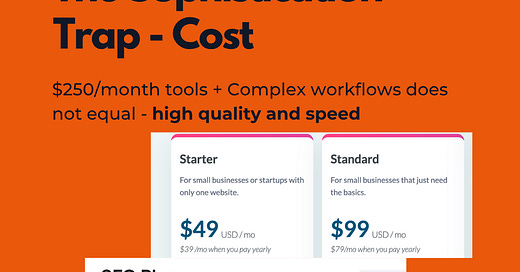Building an SEO Strategy Without Breaking the Bank: Lessons from Revarta
I spent 2 days building the "perfect" SEO workflow and threw it all away for something 10x simpler
I picked up work on Revarta’s organic traffic strategy in the last few days and got a solid reminder and learning on early product development. Here’s what I discovered while implementing a sustainable, cost-effective approach to content generation and keyword research.
Effective SEO doesn’t require expensive tools or complex workflows — especially in the early stages.
The Sophistication Trap
I started by looking at the “standard” SEO toolkit. The reality hit quickly: quality SEO tools easily run $250+ per month just for data and insights, before you even think about content generation. For an early-stage product like Revarta, that’s a significant investment with uncertain returns. They also didn’t seem to get me all the way there and left the execution bits out.
I explored workflow tools like n8n for this. The quick learning was that sophisticated workflow tools assume you already have a structured pipeline, defined personas, and clarity of the process. But when you’re still figuring things out, that level of sophistication can actually slow you down.
The power and configurability of n8n was impressive — you can build incredibly sophisticated automation pipelines. But I quickly realized I was solving the wrong problem. I was too early for a highly structured process when what I needed was flexibility and rapid iteration.
After testing several options including Relevance AI, I landed on a surprisingly simple solution: Claude Desktop paired with DataForSEO’s MCP. This combination gave me everything I needed backed with data and rationale:
Quick keyword research and competitive analysis
Content idea generation based on actual search trends
Architecture planning without rigid constraints
High-quality visualizations and output
The Power of “Good Enough” Tools
What struck me most was how effective this lean approach became. Instead of spending weeks configuring the perfect workflow, I could:
Research keywords based on Google Trends and Reddit discussions in minutes
Generate content ideas that actually match search intent
Create content architecture that builds on itself over time
Iterate quickly based on what’s working
The key insight: early-stage product development is more about learning what resonates than executing a perfect process and architecture.
CAUTION: There is a balance here. You don’t want to stay in “scrappy mode” forever. The signals to add more sophistication: when you’re consistently hitting content volume targets, when you have clear patterns in what performs, and when manual processes become the bottleneck rather than learning or quality.
What I’d Do Differently and Save Myself 2 Days
Those 2 days would have been spent configuring automation workflows, setting up data pipelines, and debugging integrations before I could even start researching keywords. Instead, with the simple approach, I was generating content ideas and competitive insights within hours.
Start with flexibility over sophistication. Your content strategy will evolve rapidly as you learn what works. Rigid workflows can become obstacles.
Invest in data, not tools. Quality data sources like DataForSEO give you the foundation. LLMs can handle the interpretation, strategy and execution.
Focus on repeatability, not perfection. A simple process you can execute weekly beats a complex system you use once.
My Actual DataForSEO + Claude Workflow
Since this became my winning approach, here’s what the actual process looks like:
Query DataForSEO for keyword difficulty, search volume, and competitor analysis around topics relevant to interview prep and career development
Feed the raw data to Claude with context about Revarta’s target audience (job seekers, career changers)
Ask specific questions like “Which of these keywords represent the highest opportunity for a new product?” or “What content architecture would address these search intents?”
Generate content briefs that map directly to search intent while staying true to our product value
The whole cycle takes about 30 minutes for a week’s worth of content direction, versus days of setup with traditional tools.
The Bigger Reminder for Builders and Myself
In early stages, the most sophisticated solution is not often the right solution. Whether it’s tech architecture, team structure, or marketing strategy, optimizing for learning and iteration often trumps optimizing for efficiency.
The tools that feel “too simple” might be exactly what you need to move fast and stay focused on what matters.
As a builder, I can easily get drawn to elegant, complex solutions. But sometimes the best strategy is the one that gets you moving fast.
The Meta Lesson
The meta lesson here: when you’re building something new, resist the urge to over-engineer your growth systems. Start simple, learn fast, and scale complexity only when you have clarity on what works.
This applies beyond SEO — it’s the same principle I’ve seen work across product development, team building, and go-to-market strategy. Early-stage success comes from speed of learning, not sophistication of process.







